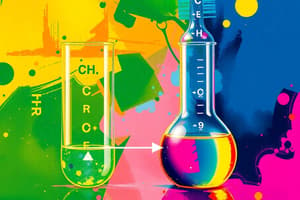Podcast
Questions and Answers
Which process involves the synthesis of simple substances into complex substances?
Which process involves the synthesis of simple substances into complex substances?
- Equilibrium
- Homeostasis
- Anabolism (correct)
- Catabolism
What type of reactions usually involve carbon reduction and consume cellular energy?
What type of reactions usually involve carbon reduction and consume cellular energy?
- Catabolic reactions
- Homeostasis reactions
- Equilibrium reactions
- Anabolic reactions (correct)
Which process involves the breakdown of complex substances into simpler substances?
Which process involves the breakdown of complex substances into simpler substances?
- Homeostasis
- Equilibrium
- Anabolism
- Catabolism (correct)
What type of reactions usually involve carbon oxidation and produce energy for the cell?
What type of reactions usually involve carbon oxidation and produce energy for the cell?
What is chemical equilibrium?
What is chemical equilibrium?
What is the color change observed when N2O4 reaches equilibrium?
What is the color change observed when N2O4 reaches equilibrium?
What principle describes the response of a system at equilibrium to an external stress?
What principle describes the response of a system at equilibrium to an external stress?
When does a chemical reaction reach equilibrium?
When does a chemical reaction reach equilibrium?
What does the equilibrium constant (Keq) represent?
What does the equilibrium constant (Keq) represent?
What does ΔG at equilibrium being zero indicate?
What does ΔG at equilibrium being zero indicate?
What does Le Châtelier’s Principle state?
What does Le Châtelier’s Principle state?
What effect does adding a catalyst have on an equilibrium system?
What effect does adding a catalyst have on an equilibrium system?
What factors can shift the equilibrium position according to Le Châtelier’s Principle?
What factors can shift the equilibrium position according to Le Châtelier’s Principle?
What does a catalyst do to the rate of a reaction?
What does a catalyst do to the rate of a reaction?
What are enzymes?
What are enzymes?
How is metabolism classified?
How is metabolism classified?
What influences the rate of a chemical reaction?
What influences the rate of a chemical reaction?
What do enzymes permit in living organisms?
What do enzymes permit in living organisms?
How are enzymes classified?
How are enzymes classified?
Flashcards
Anabolism
Anabolism
Synthesis of simple substances into complex substances.
Anabolic Reactions
Anabolic Reactions
Reactions that reduce carbon and consume cellular energy.
Catabolism
Catabolism
Breakdown of complex substances into simpler substances.
Catabolic Reactions
Catabolic Reactions
Signup and view all the flashcards
Chemical Equilibrium
Chemical Equilibrium
Signup and view all the flashcards
N2O4 Equilibrium Color Change
N2O4 Equilibrium Color Change
Signup and view all the flashcards
Le Chatelier’s Principle
Le Chatelier’s Principle
Signup and view all the flashcards
When Reaction Reaches Equilibrium
When Reaction Reaches Equilibrium
Signup and view all the flashcards
Equilibrium Constant (Keq)
Equilibrium Constant (Keq)
Signup and view all the flashcards
ΔG at Equilibrium
ΔG at Equilibrium
Signup and view all the flashcards
Le Châtelier’s Principle Stated
Le Châtelier’s Principle Stated
Signup and view all the flashcards
Effect of Catalyst on Equilibrium
Effect of Catalyst on Equilibrium
Signup and view all the flashcards
Factors Shifting Equilibrium
Factors Shifting Equilibrium
Signup and view all the flashcards
What Does a Catalyst Do?
What Does a Catalyst Do?
Signup and view all the flashcards
Enzymes
Enzymes
Signup and view all the flashcards
Metabolism Classification
Metabolism Classification
Signup and view all the flashcards
Influences on Reaction Rate
Influences on Reaction Rate
Signup and view all the flashcards
Enzymes Permit What?
Enzymes Permit What?
Signup and view all the flashcards
Enzyme Classification
Enzyme Classification
Signup and view all the flashcards
Study Notes
Chemical Equilibrium and Rates of Reactions
- At equilibrium, the rates of forward and reverse reactions are equal, and the concentrations of reactants and products are constant.
- The equilibrium constant (Keq) represents the unchanging concentrations of reactants and products at equilibrium, and it is calculated using the molar concentrations of all species in the reaction.
- ΔG at equilibrium is zero, indicating no net flow in either the forward or reverse direction, and neither process is favored.
- Le Châtelier’s Principle states that if an external stress is applied to a system at equilibrium, the system adjusts to partially offset the stress as it reaches a new equilibrium position.
- Changes in concentration, pressure, volume, and temperature can shift the equilibrium position according to Le Châtelier’s Principle.
- Adding a catalyst does not change the equilibrium constant (Keq) or shift the position of an equilibrium system, but it speeds up the reaction.
- The rate of a chemical reaction depends on the concentration of reacting species, reaction temperature, presence of catalysts, and the nature of the reactants.
- A catalyst promotes or increases the rate of a reaction without undergoing any permanent chemical change.
- Enzymes, which are biological catalysts, permit reactions to occur at conditions tolerable to the body and are very specific in their action, processing millions of molecules every second.
- Enzymes are classified based on the type of reaction they catalyze, such as oxidoreductase, transferase, hydrolase, lyase, isomerase, and ligase.
- Metabolism, the sum of all chemical reactions in a living organism, can be subdivided into two categories: catabolism (breaking down of complex molecules) and anabolism (building of complex molecules).
- The rate of a reaction is influenced by the concentration of reacting species, reaction temperature, presence of catalysts, and the nature of the reactants.
Studying That Suits You
Use AI to generate personalized quizzes and flashcards to suit your learning preferences.




